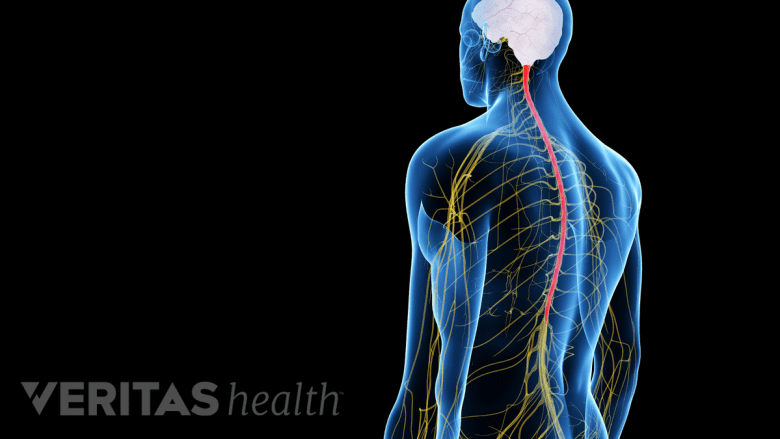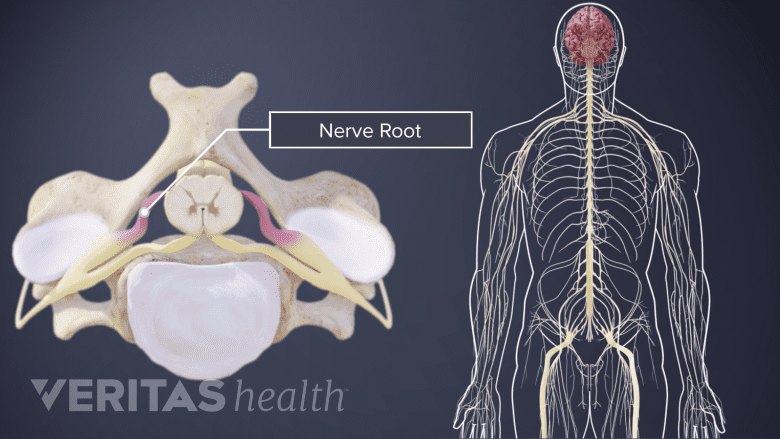The spinal cord starts at the base of the brain, runs throughout the cervical and thoracic spine, and typically ends at the lower part of the thoracic spine.
The spinal cord is an extension of the body's central nervous system.
The spinal cord does not run through the lumbar spine (lower back). After the spinal cord stops in the lower thoracic spine, the nerve roots from the lumbar and sacral levels come off the bottom of the cord like a "horse's tail" (named the cauda equina) and exit the spine.
Because the lumbar spine has no spinal cord and has a large amount of space for the nerve roots, even serious conditions—such as a large disc herniation—do not typically cause paraplegia (loss of motor function in the legs).
In This Article:
- Spinal Anatomy and Back Pain
- Vertebrae in the Vertebral Column
- Spinal Discs
- Spinal Cord and Spinal Nerve Roots
- Back Muscles and Low Back Pain
- Sacrum (Sacral Region)
- Spine Anatomy Overview Video
Spinal Cord and Spinal Nerve Root Anatomy
Spinal nerve roots branch off from either side of the spinal cord.
The spinal cord can be divided into segments according to the nerve roots that branch off from it. There are a total of:
- 8 cervical spinal nerves
- 12 thoracic spinal nerves
- 5 lumbar spinal nerves
- 5 sacral spinal nerves
- 1 coccygeal spinal nerve
For most spinal segments, the nerve roots run through the bony canal, and at each level a pair of nerve roots exits from the spine.
- Cervical spine nerve roots. In the neck, the nerve root is named for the lower segment that it runs between (e.g. C6 nerve root at C5-C6 segment).
- Lumbar spine nerve roots. In the lower back, the nerve is named for the upper segment that it runs between (e.g. L4 nerve root at L4-L5 segment).
Spinal Nerve Irritation from a Herniated Disc
A herniated spinal disc can compress the spinal cord or spinal nerve root.
The nerve passing to the next level runs over a weak spot in the disc space, which is the reason discs tend to herniate right under the nerve root.
- Cervical disc herniations (in the neck) tend to irritate the C6 spinal nerve exiting at the C5-C6 spinal segment.
- Lumbar disc herniations (in the low back) tend to irritate the L4 spinal nerve exiting at the L4-L5 spinal segment.
- Thoracic disc herniations (in the upper back) are less common than in the neck or lower spine, but they do occur.
Sometimes, a herniated disc will cause only leg pain or arm pain and not lower back pain or neck pain, and may initially be thought to be a problem with the patient's leg or arm.
- Arm pain from a cervical disc herniation is usually accompanied by numbness/tingling and runs to the fingers.
- Leg pain from a lumbar disc herniation will usually run below the knee, and possibly to the foot, and may be accompanied by numbness or other neurological symptoms.
The Essentials of a Pinched Lumbar Spinal Nerve
The L5 and S1 spinal nerve roots are at a higher risk of irritation or compression.
The two nerves most commonly pinched in the lower back are L5 and S1.
- Pinched nerve at L5-S1 spinal segment. The L5 nerve supplies the nerves to the muscles that raise the foot and big toe, and consequently, impingement of this nerve may lead to weakness in these muscles. Numbness for L5 runs over the top of the foot.
- Pinched nerve at S1-S2 spinal segment. Impingement of the S1 nerve can lead to weakness with the large gastronemius muscle in the back of the calf, causing difficulty with foot push, along with numbness on the outer side of the foot. The S1 nerve root is also responsible for the ankle jerk reflex (tapping on the achilles tendon causes the foot to go down), therefore a loss of this reflex indicates S1 impingement.
The Essentials of a Pinched Cervical Spinal Nerve
Different symptoms are caused by the impingement of various nerve roots.
Most cervical pathology will lead to pinching of either C6 or C7 nerve roots in the neck, although sometimes the C5 or C8 nerves may be pinched.
Depending on which nerve root is pinched, the following symptoms are likely:
- Pinched nerve at C5. This can cause shoulder pain, deltoid weakness, and possibly a small area of numbness in the shoulder. On physical exam, a patient’s biceps reflex may be diminished.
- Pinched nerve at C6. This can cause weakness in the biceps and wrist extensors, and pain/numbness that runs down the arm to the thumb. On physical exam, the brachioradialis reflex (mid-forearm) may be diminished.
- Pinched nerve at C7. This can cause pain/numbness that runs down the arm to the middle finger. On physical exam, the triceps reflex may be diminished.
- Pinched nerve at C8. This can cause hand dysfunction (this nerve supplies innervation to the small muscles of the hand). Pain/numbness can run to the outside of the hand (little finger) and impair its reflex.
Read more about Cervical Spinal Nerves
Healing from a Pinched Nerve
Nerves can takes weeks to months to heal.
The nerve consists of one long cell from the low back or neck down to the foot or hand, so the nerves tend to heal slowly. The nerves heal from the top down, and depending on how much damage is done at the time the nerve becomes impinged (pinched), it may take weeks to months for the nerve to fully to heal.
Treatment of neural impingement is directed at relieving the pain and then allowing the nerve to heal on its own. Nerves need both inflammation and pressure to be painful, so either relieving the inflammation or the pressure can relieve the pain.











